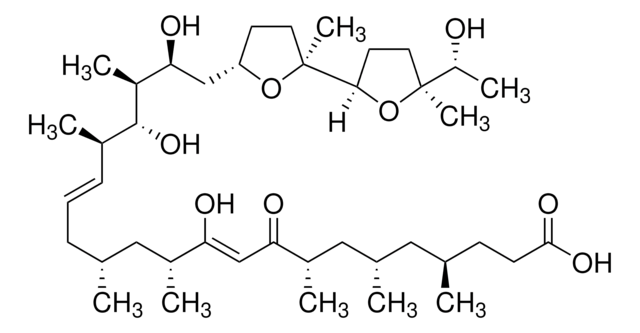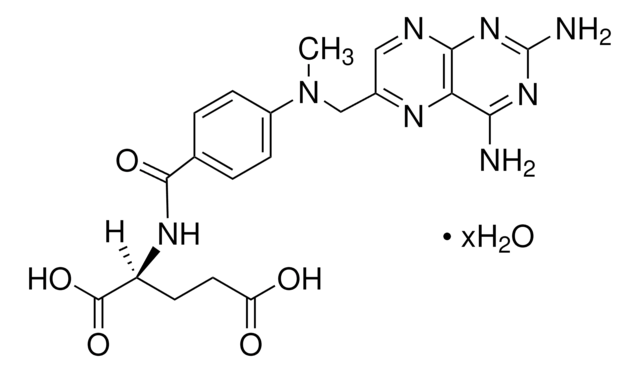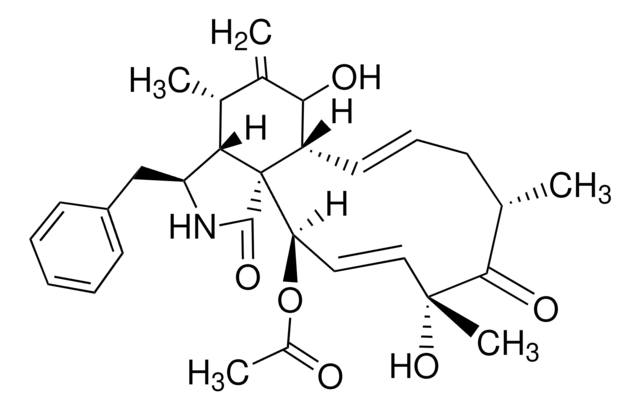M7949
Mitomycin C from Streptomyces caespitosus
≥98% (HPLC), potency: ≥970 μg per mg (USP XXIV), γ-irradiated, suitable for cell culture
About This Item
Recommended Products
biological source
Streptomyces caespitosus
Quality Level
sterility
γ-irradiated
Assay
≥98% (HPLC)
form
powder or crystals
potency
≥970 μg per mg (USP XXIV)
technique(s)
cell culture | mammalian: suitable
color
dark blue
mp
>360 °C
solubility
DMSO: 1.0 mg/mL
antibiotic activity spectrum
Gram-negative bacteria
Gram-positive bacteria
neoplastics
Mode of action
DNA synthesis | interferes
storage temp.
2-8°C
SMILES string
[H][C@]12CN3C4=C([C@@H](COC(N)=O)[C@@]3(OC)[C@@]1([H])N2)C(=O)C(N)=C(C)C4=O
InChI
1S/C15H18N4O5/c1-5-9(16)12(21)8-6(4-24-14(17)22)15(23-2)13-7(18-13)3-19(15)10(8)11(5)20/h6-7,13,18H,3-4,16H2,1-2H3,(H2,17,22)/t6-,7+,13+,15-/m1/s1
InChI key
NWIBSHFKIJFRCO-WUDYKRTCSA-N
Looking for similar products? Visit Product Comparison Guide
Related Categories
Application
Biochem/physiol Actions
Antimicrobial Spectrum: Mitomycin C has strong antitumor activity, especially against Ehrlich ascites tumor cells, and strong bactericidal action against gram-positive and gram-negative bacteria.
Caution
Preparation Note
Signal Word
Danger
Hazard Statements
Precautionary Statements
Hazard Classifications
Acute Tox. 2 Oral - Carc. 2
Storage Class Code
6.1A - Combustible acute toxic Cat. 1 and 2 / very toxic hazardous materials
WGK
WGK 3
Flash Point(F)
Not applicable
Flash Point(C)
Not applicable
Regulatory Listings
Regulatory Listings are mainly provided for chemical products. Only limited information can be provided here for non-chemical products. No entry means none of the components are listed. It is the user’s obligation to ensure the safe and legal use of the product.
JAN Code
M7949-5MG:
M7949-BULK:
M7949-2MG-PW:
M7949-VAR:
M7949-2MG:
Certificates of Analysis (COA)
Search for Certificates of Analysis (COA) by entering the products Lot/Batch Number. Lot and Batch Numbers can be found on a product’s label following the words ‘Lot’ or ‘Batch’.
Already Own This Product?
Find documentation for the products that you have recently purchased in the Document Library.
Customers Also Viewed
Articles
Antibiotic kill curve is a dose response experiment in which mammalian cells are subjected to increasing amounts of selection antibiotic
Our team of scientists has experience in all areas of research including Life Science, Material Science, Chemical Synthesis, Chromatography, Analytical and many others.
Contact Technical Service














